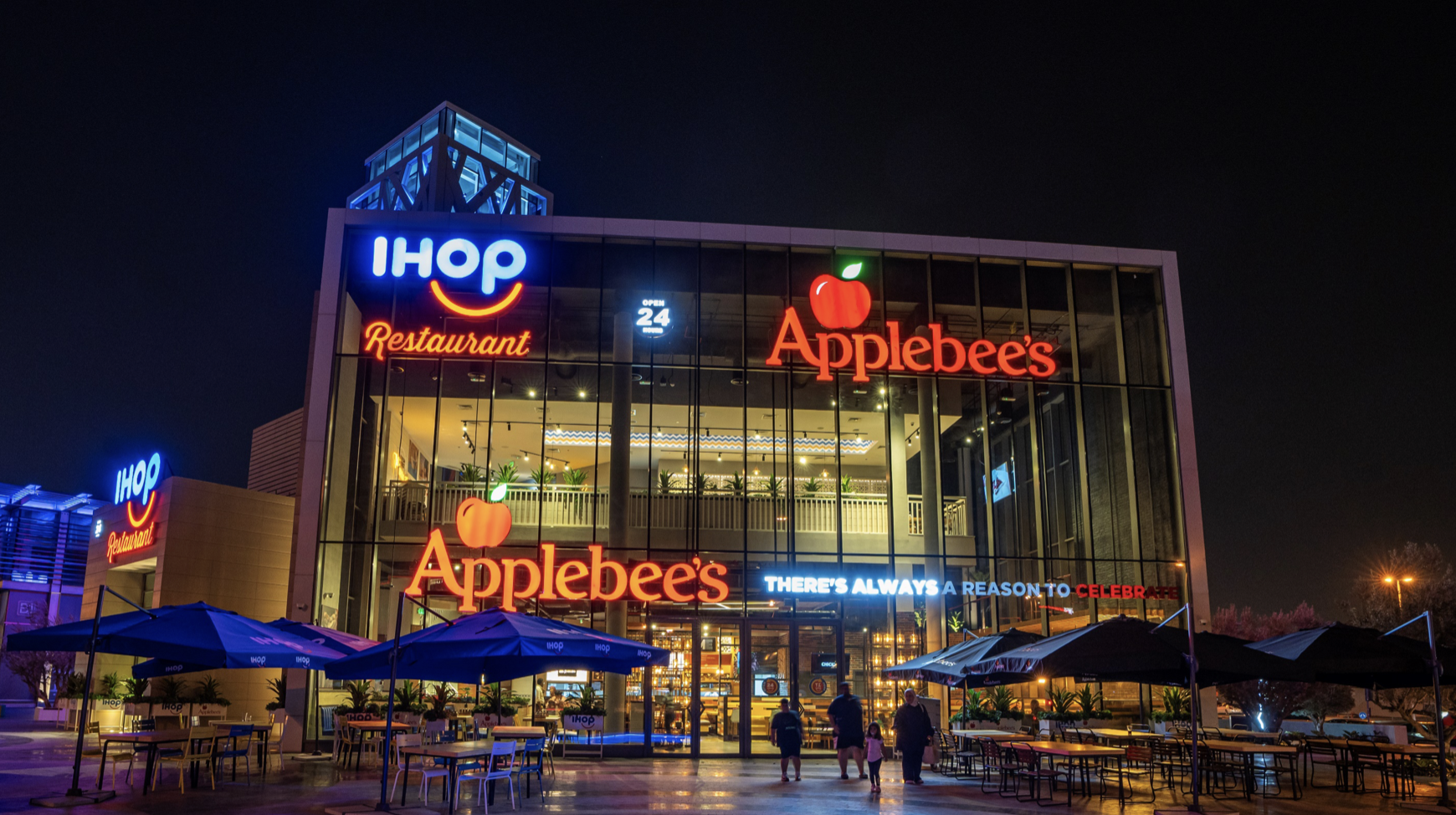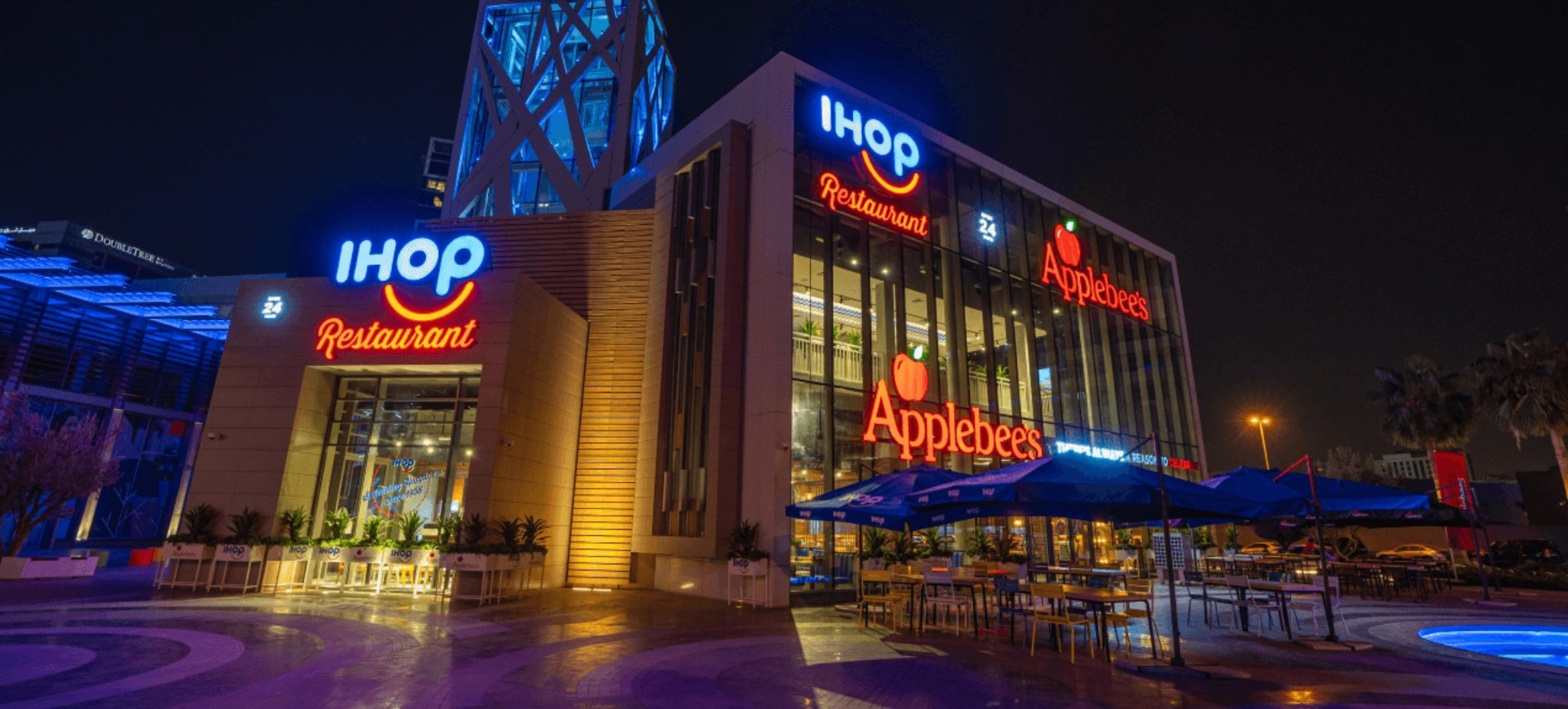John Peyton, CEO of Dine Brands, thinks of his company as a brand company. After all, with the exception of a test kitchen in Dallas, all 3,700 of its restaurants are franchised. Its brands include IHOP, Applebee’s, and Fuzzy’s Taco Shop—an impressive group given they’ve been around for 65, 50, and 20 years respectively.
“As a franchisor, we win when our brands are different, better, and special,” Peyton said at RestaurantSpaces in Los Angeles, a lesson he first learned as Chief Marketing Officer at Starwood Hotels and Resorts, where he worked for 20 years.
He went on to explain how succeeding in today’s restaurant industry requires adapting to shifting consumer expectations, investing in employees, and staying agile.
Their philosophy. Building really strong brands.
The Evolution of Branding
Whereas branding used to mostly involve coming up with memorable TV ads, Peyton explained, it’s much more sophisticated today. It requires making an emotional connection with consumers at multiple touchpoints—physical and digital.
“Each of our brands has a story to tell,” Peyton said. “Everything you do, every touchpoint has got to tell the brand’s story—whether it’s the clothing the team members are wearing, the tone of voice, the design of the restaurant, the experience on the apps … As we like to say, everything communicates.”
Lasting brands must also innovate. They’ve got to give their guests “what they can’t imagine,” Peyton said, citing a famous quote by car inventor Henry Ford: “If I had asked people what they wanted, they would have said faster horses.” In other words, to stay ahead of the game, brands must anticipate their customers’ needs and wants.
“In today’s world of great change,” Peyton said, “having a strong brand that tells a great story and has a strong point of view is step one to succeeding today.”
Building and Retaining Great Talent With Empathy
Step two to building a successful restaurant brand is investing in your employees.
“For years, we’ve been talking about B2B relationships and B2C relationships,” Peyton said. “But it’s really important to think about B2E relationships: business-to-employee relationships.”
Why? Because working in a restaurant has never been more challenging, especially for general managers.
“New sales channels, outdoor dining, third-party delivery, recovering from Covid and all the requirements from that, staffing shortages, retaining staff, and the explosion of technology off-premise and on-premise make running a restaurant an almost impossible job,” Peyton said.
However, by showing empathy and empowering team members to solve challenges on their own, restaurant owners can develop and retain great talent.
“Empathy isn’t just about nurturing your team members. It’s about allowing for their full participation,” Peyton said. Ultimately, “to win in the marketplace, you first have to win in the workplace. It’s all about our people and our talent.”
Playing Offense, Not Just Defense
While the last few years have been challenging, it’s not enough to just play defense. Successful brands must also invest in the future.
One example from Dining Brands is IHOP’s International Bank of Pancake loyalty program, which they invested in during the pandemic when eating out took a major hit. Now the program has nearly 9 million members—those active on the platform visit more often and spend more—and accounts for almost 7 percent of sales.
More recently, Dining Brands took the IHOP loyalty program a step further by adding an AI recommendation engine to its app. Now app users accept its menu recommendations 73 percent of the time, further boosting sales.
The moral of the story? Innovating during a downturn can really pay off.
Disrupting as an Established Player
With technology improving exponentially, it also pays to be at the forefront of disruption.
“We can’t let just the startups be the disruptors,” Peyton said. “We have to make sure that large companies like ours act in a disruptive way as well and not get buried in our bureaucracy and our process.”
For a company like Dine Brands, which has 400 franchisees and nearly $10 million in system sales, that means leveraging its size, scale, and brand. “We have a position of strength from which we can innovate,” Peyton said.
For example, Dine Brands recently rolled out eight dual-branded restaurants internationally. These are locations that house two restaurants in what would normally be the footprint for one, potentially bringing in twice the revenue.

A co-branded IHOP and Applebee's location.
It helps that IHOP and Applebee’s are complementary brands from a daypart perspective.
“IHOP is primarily an AM brand. Applebee’s is primarily a PM brand. So when you put the two together, you get a fully utilized kitchen and physical space,” Peyton explained. Now the company is working on testing the concept in the U.S.
Another way Dine Brands is leveraging its scale is by launching CPG products like IHOP coffee, which is now sold in over 40,000 supermarkets nationwide. According to the company’s partner Kraft Heinz, it’s been the fastest-growing launch of a new coffee label in years, particularly among Gen Z and millennials.
Ultimately, it’s helped Dine Brands “make sure that we’re in front of our guests at multiple touchpoints in their lives, not just when they’re in our restaurants,” Peyton said.

Investing in Viral Marketing
Dine Brands has also invested in viral marketing. In January, Applebee’s offered a limited number of $200 “Date Night” passes, which give pass holders a $30 credit every week for a year (a nearly $1,600 value). The passes sold out in less than a minute.
The restaurant then repeated the initiative in February, incorporating feedback from the first round by replacing the first-come, first-served system with a random selection of 1,000 winners. Both times, the response resulted in major unpaid publicity as the winners posted about their date nights on social media. 
In addition, Dine Brands has increased its off-premise business from 6-7 percent of sales before COVID to 22-23 percent after COVID by adding geofencing, predictive analytics, improved POS systems, and other tech to its businesses.
“We’ve done everything we can to make sure that we can meet our guests where they are, when they want to talk to us, through what channel, and how they want to dine with us,” Peyton said.
Big, Hairy, Audacious Goals
Finally, all of Dine Brands’ recent successes are a result of setting what Peyton calls “big, hairy, audacious goals” or “BHAGs.” They allow the company to stretch its limits, avoid becoming complacent, and keep up with current trends.
“In this increasingly digital world, in this increasingly connected world, in which our guests are changing their attitudes and desires so rapidly, you’ve got to figure out new ways to fit into your guests’ lives,” Peyton said.
One example of the changing market is inflation, which pressures restaurants to prove their value to consumers. “When people are coming out to dine with us and they’re spending more than they once did, it’s all about the experience,” Peyton said.
Dine Brands’s value lies in “great food at a great price, an abundant portion, but most importantly, it’s the experience,” Peyton said.
That’s why Dine Brands expects its team members to connect with customers on an emotional level.
“In that one minute they have with their customer, how can they make that connection that will bring them back and make them loyal for life?”

Posted by
Chain Restaurants Reimagined.
The Retreat to Reimagine Restaurant Development, Design + Technology.
April 12-14, 2026 | Miami, FL





-3.png)

-3.png)
-4.png)
-3.png)

Comments